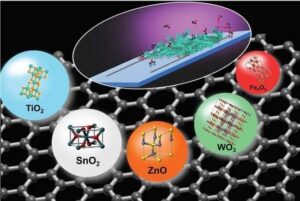Prelims – Science – Chemistry

A new metal oxide nanocomposite has been created to enhance the photocatalytic breakdown of organic pollutants, including dyes and pharmaceutical residues.
About the Nanocomposite
- The material was developed by the Institute of Advanced Study in Science and Technology (IASST), an autonomous institution under the Department of Science and Technology (DST).
- It is a composite made of Nickel-doped Titanium Dioxide (Ni-TiO₂) supported on Fuller’s earth, referred to as NiTF.
- This nanocomposite was tested for its ability to degrade methylene blue, a common dye, through photocatalysis.
- Fuller’s earth enhanced the adsorption ability of TiO₂ even in the absence of light, making it a cost-effective solution for pollution control.
Understanding Metal Oxide Photocatalysis
- Photocatalysis involves the use of light-activated metal oxides that trigger chemical reactions.
- When exposed to light, these catalysts generate electron-hole pairs, which facilitate oxidation-reduction reactions to break down complex pollutants into simpler, non-toxic compounds.
- Common photocatalysts include:
- Titanium dioxide (TiO₂)
- Zinc oxide (ZnO)
- Tungsten trioxide (WO₃)
Factors Influencing Photocatalytic Efficiency
- Type of metal oxide used
- Crystalline structure of the catalyst
- Light source and intensity
- Concentration of the pollutant
- pH level of the solution
- Amount of catalyst added
Key Applications
- Water purification: Removal of persistent organic contaminants from wastewater
- Renewable energy: Hydrogen production via water splitting
- Solar energy: Use in solar cells for better efficiency
- Gas detection: Highly sensitive chemical sensors
- Medical field: Employed as antimicrobial agents
- Coatings and electronics: In self-cleaning surfaces and optoelectronic devices
Photocatalytic Degradation
- It is an advanced oxidation technique that utilizes light to activate catalysts.
- Especially useful for degrading non-biodegradable, high-concentration, and complex organic compounds in polluted water.




